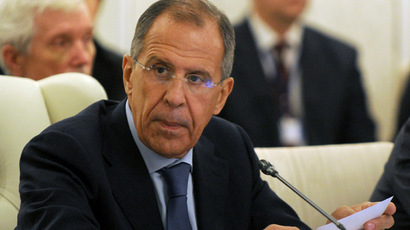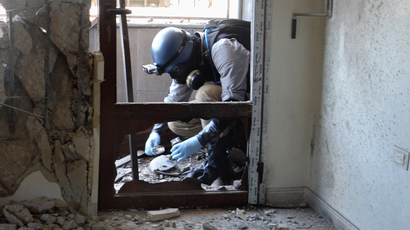First batch of chemical weapons leaves Syria - OPCW

The first batch of Syrian chemical weapons has left the Syrian port of Latakia on a Danish ship "for international waters", the Organization for the Prohibition of Chemical Weapons said in a statement.
"The vessel has been accompanied by naval escorts provided by Denmark and Norway, as well as the Syrian Arab Republic," the statement reads. "It will remain at sea awaiting the arrival of additional priority chemical materials at the port."
Though the international watchdog referred to the removed arms as "priority chemical materials", which came from "two sites", it did not elaborate how much of it was loaded onto the Danish commercial vessel.
Among the full arsenal of weapons to be transported will be some 20 tons of mustard nerve agent. It is intended that the weapons be destroyed abroad away from the war zone.
An OPCW statement published on November 15 outlined the plan for the destruction of the chemicals. After the “most critical” chemicals are removed, all other chemical substances – excluding isopropanol (a key ingredient in the production of sarin) – will be taken out of the country by February 5. The “sequenced destruction,” runs according to a “risk-based criterion.”
The initial deadline for taking the first chemical consignment out of Syria was set for December 31, meaning Norwegian and Danish ships were forced to return to port in Cyprus a week ago. The reasons cited for the delay were “war, bad weather and bureaucracy,” according to an OPCW official.
The passage of the chemicals through international waters is being safeguarded through the provision of ‘naval escorts’ from Russia, Denmark, Norway and China.
Syria agreed to the destruction of its chemical weapons by June through a deal brokered by Russia, which defused Washington’s intention to use military force against Syria. The deal followed a sarin gas attack on August 21 that western nations accused President Bashar Assad of orchestrating. Syria says that rebels were responsible for the use of chemical agents.
A US vessel, the cargo ship MV Cape Ray is prepared to set sail for the coast of Italy, where it will receive the load to destroy in international waters. The actual work could probably take 45 days under ideal conditions, but the mission is now expected to last about 90 days because of bad weather.
Russia, as well as providing an escort warship, Pyotr Veliky, has sent 75 armored trucks to Syria and allocated $2 million in funds and other equipment to be used for the chemical weapons elimination process, Russian Defense Minister Sergey Shoigu said on December 23.
The Syrian government is shouldering the responsibility of ensuring that chemical weapons are safely packaged and delivered to the port – including their passage through areas in which rebels remain active.














